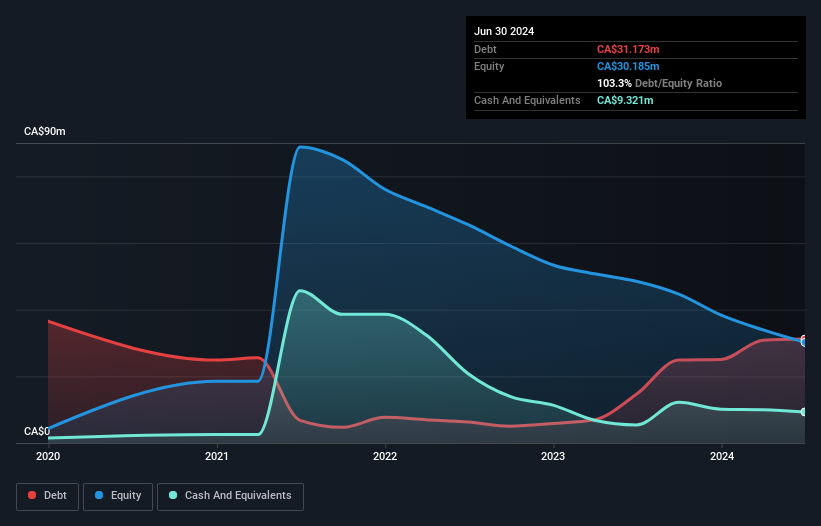Some say volatility, rather than debt, is the best way to think about risk as an investor, but Warren Buffett famously said that 'Volatility is far from synonymous with risk.' So it might be obvious that you need to consider debt, when you think about how risky any given stock is, because too much debt can sink a company. We note that Tekna Holding ASA (OB:TEKNA) does have debt on its balance sheet. But the more important question is: how much risk is that debt creating?
Why Does Debt Bring Risk?
Debt and other liabilities become risky for a business when it cannot easily fulfill those obligations, either with free cash flow or by raising capital at an attractive price. Ultimately, if the company can't fulfill its legal obligations to repay debt, shareholders could walk away with nothing. However, a more frequent (but still costly) occurrence is where a company must issue shares at bargain-basement prices, permanently diluting shareholders, just to shore up its balance sheet. Having said that, the most common situation is where a company manages its debt reasonably well - and to its own advantage. When we examine debt levels, we first consider both cash and debt levels, together.
See our latest analysis for Tekna Holding
How Much Debt Does Tekna Holding Carry?
As you can see below, at the end of June 2024, Tekna Holding had CA$31.2m of debt, up from CA$14.6m a year ago. Click the image for more detail. However, it does have CA$9.32m in cash offsetting this, leading to net debt of about CA$21.9m.

How Healthy Is Tekna Holding's Balance Sheet?
Zooming in on the latest balance sheet data, we can see that Tekna Holding had liabilities of CA$9.83m due within 12 months and liabilities of CA$32.5m due beyond that. On the other hand, it had cash of CA$9.32m and CA$11.2m worth of receivables due within a year. So its liabilities outweigh the sum of its cash and (near-term) receivables by CA$21.8m.
While this might seem like a lot, it is not so bad since Tekna Holding has a market capitalization of CA$67.7m, and so it could probably strengthen its balance sheet by raising capital if it needed to. However, it is still worthwhile taking a close look at its ability to pay off debt. When analysing debt levels, the balance sheet is the obvious place to start. But you can't view debt in total isolation; since Tekna Holding will need earnings to service that debt. So if you're keen to discover more about its earnings, it might be worth checking out this graph of its long term earnings trend.
In the last year Tekna Holding wasn't profitable at an EBIT level, but managed to grow its revenue by 22%, to CA$40m. Shareholders probably have their fingers crossed that it can grow its way to profits.
Caveat Emptor
Despite the top line growth, Tekna Holding still had an earnings before interest and tax (EBIT) loss over the last year. Its EBIT loss was a whopping CA$14m. Considering that alongside the liabilities mentioned above does not give us much confidence that company should be using so much debt. So we think its balance sheet is a little strained, though not beyond repair. Another cause for caution is that is bled CA$14m in negative free cash flow over the last twelve months. So suffice it to say we consider the stock very risky. When analysing debt levels, the balance sheet is the obvious place to start. But ultimately, every company can contain risks that exist outside of the balance sheet. For example Tekna Holding has 4 warning signs (and 2 which are potentially serious) we think you should know about.
If you're interested in investing in businesses that can grow profits without the burden of debt, then check out this free list of growing businesses that have net cash on the balance sheet.
Valuation is complex, but we're here to simplify it.
Discover if Tekna Holding might be undervalued or overvalued with our detailed analysis, featuring fair value estimates, potential risks, dividends, insider trades, and its financial condition.
Access Free AnalysisHave feedback on this article? Concerned about the content? Get in touch with us directly. Alternatively, email editorial-team (at) simplywallst.com.
This article by Simply Wall St is general in nature. We provide commentary based on historical data and analyst forecasts only using an unbiased methodology and our articles are not intended to be financial advice. It does not constitute a recommendation to buy or sell any stock, and does not take account of your objectives, or your financial situation. We aim to bring you long-term focused analysis driven by fundamental data. Note that our analysis may not factor in the latest price-sensitive company announcements or qualitative material. Simply Wall St has no position in any stocks mentioned.
About OB:TEKNA
Tekna Holding
Engages in the development, manufacture, and sale of micron and nanopowders, and plasma process solutions in North America, Europe, Asia, and internationally.
Excellent balance sheet with very low risk.
Similar Companies
Market Insights
Community Narratives




